Could Dams Replace Glaciers In The Alps?
Future summer water shortages, expected as a consequence of ongoing glacier retreat could be substantially mitigated by water management in reservoirs. This is the result of a study led by the JRC and the Swiss Federal Research Institute WSL. The team simulated the effect of climate change on glaciers across the European Alps and estimated that one quarter of the effect on seasonal water availability could be avoided when storing water in areas that become free of ice.
A new study jointly led by the JRC and the Swiss Federal Institute for Forest, Snow and Landscape Research (WSL) presents for the first time an estimate for the potential mitigation that could be achieved when managing water with reservoirs. The idea is to transfer the additional water available during the spring to the summer month, in order to compensate for the reduction in water caused by glacier shrinkage.
The environments influenced by the presence of snow and glaciers are hotspots regarding the impact of climate change on water availability. With warmer temperatures, both the duration and the spatial extent of the snow cover are projected to decrease, and glaciers are expected to retreat substantially. This will affect the seasonality of runoff significantly, and result in a reduction of water yields from high-mountain areas.
By using the latest climate projections and a numerical glacier model recently developed at the Laboratory of Hydraulics, Hydrology and Glaciology (VAW) at ETH Zurich, Switzerland, the authors estimate that for the European Alps, up to two thirds of the expected changes could potentially be mitigated by the end of the century. For this, about 1 km3 of would need to be stored temporarily.
The authors also compared this with the volume of water that would be available if artificial dams were installed in the locations of the retreating glaciers. The authors placed virtual dams at the current glacier positions and computed the volume of each lake that was formed. The results show that the volume of water that would be potentially available is more than ten times larger than what is needed and that about a dozen of centralized dams would be sufficient for meeting the storage demand.
However, the study also highlight how such technical solution (whose environmental impacts should also be considered) would only solve a part of the problem: centralizing the water of the many glaciers (about 4000 today) across the Alps would be difficult and the hypothetical seasonal water transfer would not be able to compensate for the overall water loss caused by glacier retreat. The authors estimate that by 2100, this reduction in water yield for the European Alps would correspond to about 80% of Switzerland’s freshwater consumption.

